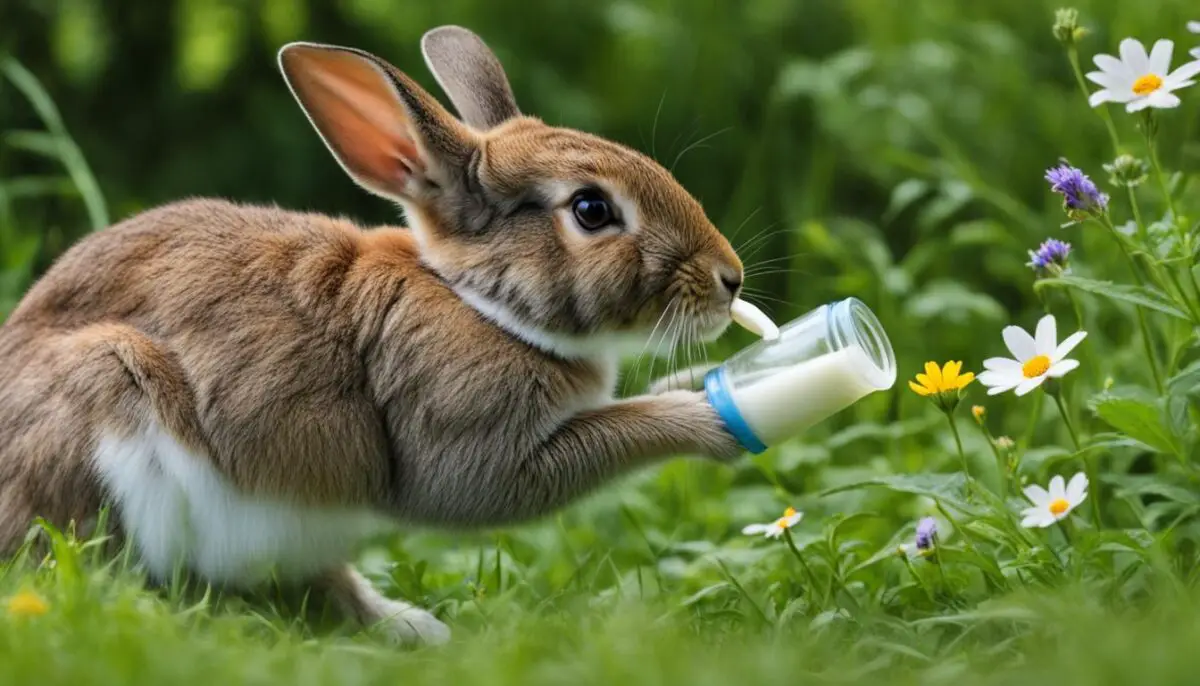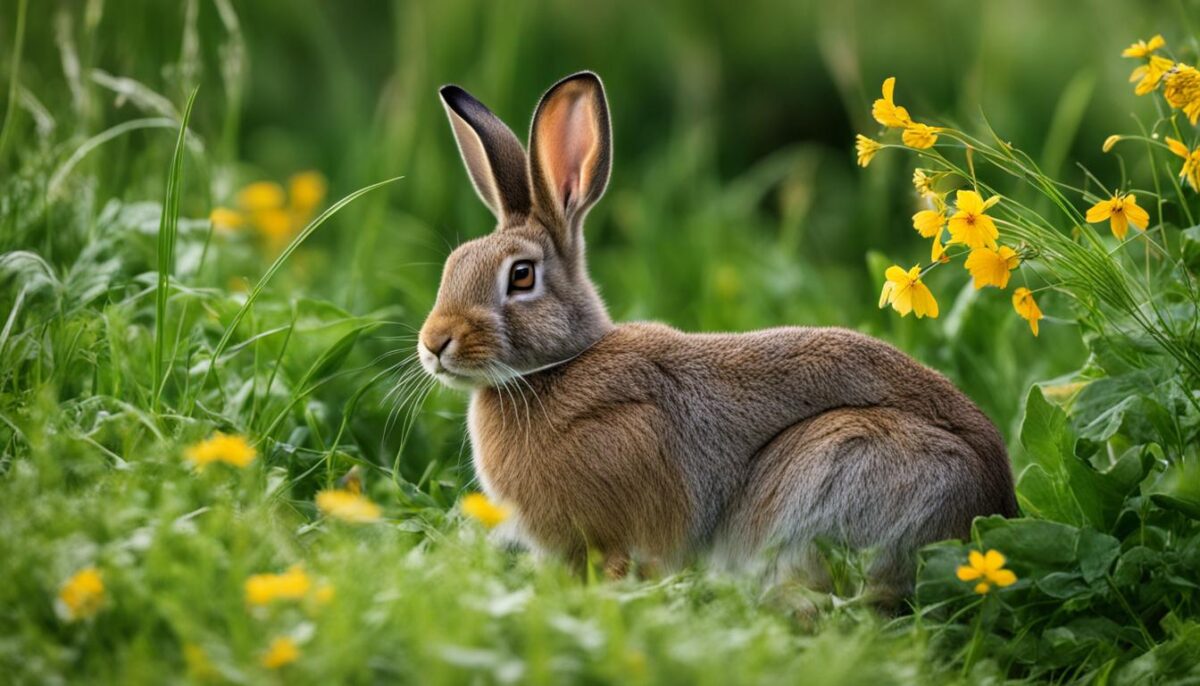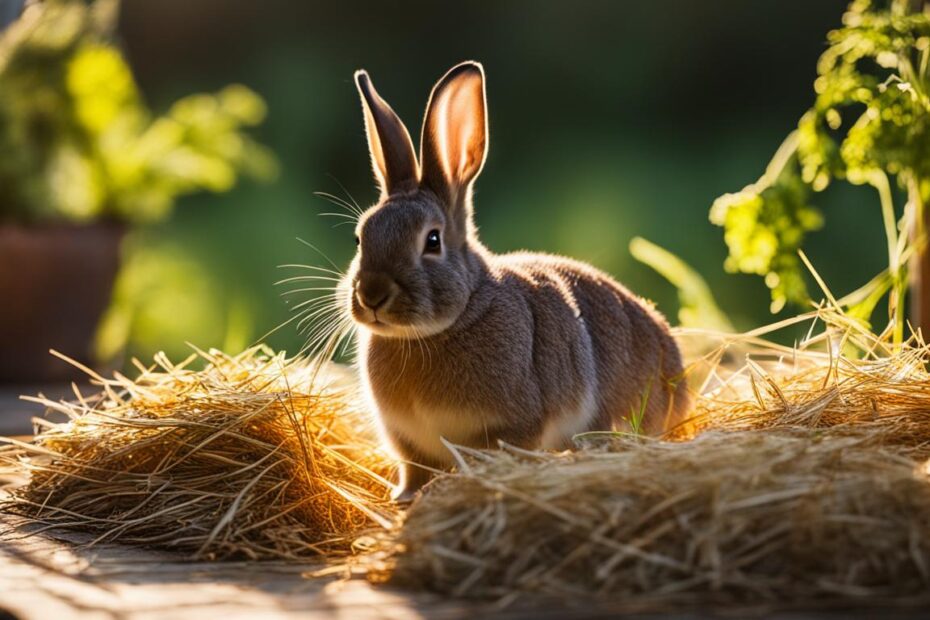When you come across a wild rabbit in need of care, it’s important to know how to provide them with the necessary support. Whether it’s an orphaned bunny or an injured rabbit, understanding the basics of wild rabbit care can make a significant difference in their well-being.
To ensure the best possible care for a wild rabbit, there are a few essential tips and guidance to follow. From creating a safe and warm nest for baby bunnies to providing a varied diet for grown rabbits, these steps will help you navigate the process with confidence and compassion.
Key Takeaways:
- Creating a temporary shelter using a wooden or plastic box lined with pesticide-free soil and dried hay is crucial for orphaned bunnies.
- Newborn baby rabbits require a warm environment, around 100°F, for the first 2 weeks of their lives.
- Feeding formula to baby rabbits is necessary for their development, and the mixture should replicate the thickness of the mother’s milk.
- Grown rabbits should have a varied diet that includes vegetables, fruits, grass, and hay.
- Weaning the rabbit off formula and preparing them for release involves gradually decreasing feedings and familiarizing them with the outside environment.
Creating a Safe and Warm Nest for Baby Bunnies
When caring for wild rabbits, it is crucial to create a secure and cozy nest for baby bunnies. By providing them with a comfortable and nurturing environment, you can help ensure their well-being as they grow. Follow these essential tips on how to take care of a wild rabbit and create the ideal nest for these adorable little creatures.
To create a safe and warm nest, begin by lining a wooden or plastic box with pesticide-free soil. This will provide a natural and comfortable base for the bunnies to rest on. Next, add a layer of dried hay on top, which will serve as additional bedding material.
To make the nest more inviting, shape it like a cozy burrow in the center of the box. This will give the bunnies a sense of security and mimic their natural habitat. Remember, it is important to handle the bunnies gently, as they are delicate creatures.
To maintain the proper temperature for the baby bunnies, place the nest on top of a heating pad or near a heat lamp. This will ensure a warm and comfortable environment, as young rabbits require a temperature of approximately 100°F during their first two weeks of life.
Finally, it is essential to protect the baby bunnies from potential dangers or disturbances. Cover the box with a screen or mesh to prevent them from jumping out or being bothered by other pets. This will provide them with a safe and secure space to thrive.

| Recommended Solid Foods |
|---|
| Grass (such as timothy grass, meadow fescue, or orchard grass) |
| Leafy greens (spinach, mustard greens, parsley) |
| Root vegetables (carrots, squash, potatoes) |
| Small amounts of fruits (bananas, berries, apples) |
Remember to monitor their reaction to new foods and introduce them slowly. This will help prevent any digestive upsets.
Providing a Varied Diet for Grown Rabbits
Once wild rabbits reach adulthood, it’s crucial to offer them a diverse and nutritious diet to ensure their health and well-being. A well-balanced diet plays a vital role in supporting their immune system, maintaining optimal weight, and promoting overall vitality. Here are some key dietary considerations for grown rabbits:
Vegetables:
Rabbits should have a regular supply of fresh vegetables as part of their diet. Include a variety of leafy greens such as spinach, mustard greens, and parsley. Carrots, squash, and potatoes can also be introduced to provide additional nutrients and dietary enrichment.
Fruits:
Incorporating fruits into a rabbit’s diet can provide essential vitamins and minerals. Offer fruits like bananas, berries, and apples as occasional treats to add variety and natural sweetness to their meals. Remember to introduce fruits in moderation due to their higher sugar content.
Grass and Hay:
Grass and hay should be the mainstay of a rabbit’s diet. Timothy grass, orchard grass, meadow fescue, and clover are excellent choices. These fibrous foods aid in digestion, wear down their teeth naturally, and prevent dental issues. Ensure a constant supply of fresh, clean grass and hay to support their nutritional needs.
Water:
Hydration is crucial for rabbits, as it helps maintain proper digestion and overall health. Provide unlimited access to clean, fresh water at all times. Ensure the water source is easily accessible and regularly replenished to prevent dehydration.
| Food | Benefits |
|---|---|
| Leafy Greens (Spinach, Mustard Greens, Parsley) | Rich in vitamins and minerals, support overall health |
| Carrots, Squash, Potatoes | Provide additional nutrients and dietary enrichment |
| Bananas, Berries, Apples (limited portions) | Offer natural sweetness and essential vitamins |
| Timothy Grass, Orchard Grass, Meadow Fescue, Clover | Ensure proper digestion, dental health, and fiber intake |
Remember, it’s important to consult with a veterinarian to ensure you are providing the appropriate and balanced diet for your wild rabbit. Each rabbit’s dietary requirements may vary based on their age, health, and specific nutritional needs.

It is crucial to wean the rabbit off formula and provide a diet of whole foods before releasing them into the wild. The transition should be gradual to ensure the rabbit’s health and adaptability to its natural environment. By reducing the number of feedings, the rabbit will learn to rely on foraging for food, mimicking its wild counterparts.
Remember, it’s necessary to minimize human contact during this stage to allow the rabbit to regain its natural instincts and behaviors.
Once the rabbit can eat a varied diet of grass and leafy greens, it can be released into a suitable habitat. This habitat should have plenty of grass, hiding places such as bushes or burrows, and a nearby water source. Release the rabbit during the early morning or evening hours when it is less likely to encounter predators and has time to acclimate to its new surroundings.
Finding a Wildlife Rehabilitator for Orphaned Bunnies
If you come across orphaned bunnies and are unable to care for them, it’s important to find a wildlife rehabilitator who can accept them. These professionals have the experience and resources to successfully raise and release wild bunnies, ensuring their best chance of survival in the wild.
When you encounter orphaned bunnies, the first step is to contact local rehabbers in your area. These individuals specialize in the care and rehabilitation of wild animals and can provide the necessary support for orphaned bunnies.
Make arrangements with the rehabber to drop off the bunnies at their facility. They will assess the bunnies’ condition and provide the appropriate care, including feeding, shelter, and medical treatment if needed.
Wildlife rehabilitators follow strict protocols to ensure the well-being and safety of the animals in their care. They have the knowledge and expertise to effectively raise the bunnies, allowing them to develop the skills necessary for survival in their natural habitat.
By entrusting orphaned bunnies to wildlife rehabilitators, you are giving them the best chance at a successful return to the wild. These dedicated professionals work tirelessly to rehabilitate and release wild animals, promoting the conservation of local wildlife populations.
Remember, if you come across orphaned bunnies and are unable to care for them, seeking the assistance of a wildlife rehabilitator is crucial. They possess the expertise and resources to provide the appropriate care and give these wild rabbits the opportunity to thrive in their natural environment.
Conclusion
Caring for a wild rabbit is a rewarding experience that requires attention and dedication. By following these essential tips and guidance on how to take care of a wild rabbit, you can ensure the health and well-being of these delicate creatures in their natural habitat.
Providing a safe shelter is crucial for orphaned bunnies. Create a temporary nest using a wooden or plastic box lined with pesticide-free soil and dried hay. Keep the newborn rabbits warm in a temperature of around 100°F for the first two weeks. Handling them gently and providing a screen cover will keep them safe from harm.
Feeding the rabbits is equally important. For the first six weeks of their lives, baby rabbits should be fed a formula. Gradually introduce them to grass, vegetables, and fruits as they grow older. Once fully grown, offer them a varied diet including vegetables, fruits, and plenty of grass and hay. Always ensure they have access to clean water.
As the rabbits mature, it’s essential to prepare them for release back into the wild. Decrease the number of feedings and introduce more grass for them to eat. Minimize your handling of the rabbit to help them become less dependent on humans. Finally, around 6 to 8 weeks old, the rabbit can be released into a suitable habitat with ample grass, hiding places, and access to water.
If you come across orphaned bunnies and are unable to care for them, it’s important to find a wildlife rehabilitator who can provide the necessary care for their successful release. Contact local rehabbers in your area to ensure the best chance of survival for these wild rabbits in their natural environment.
FAQ
How do I create a safe and warm nest for baby bunnies?
To create a safe and warm nest for baby bunnies, line a wooden or plastic box with pesticide-free soil and a layer of dried hay. Create a nest-like shape in the center of the box for the bunnies to curl up in. Place the box on top of a heating pad or near a heat lamp to maintain a temperature of 100°F for the first 2 weeks. It’s important to handle the bunnies gently and provide a screen cover to prevent them from jumping out of the box or being disturbed by other pets.
How do I feed formula to baby rabbits?
For the first 6 weeks of their lives, baby rabbits should be fed formula. Mix the formula to be 3 parts formula and 4 parts distilled water to replicate the thickness of the mother’s milk. Feed the bunnies using a syringe or eyedropper, being careful not to overfeed and cause bloating or diarrhea. It’s important to stimulate the bunny’s bowels after each feeding by gently rubbing their bottom with a cotton swab or damp paper towel. As the bunnies grow, they can be introduced to grass, vegetables, and fruits.
What should I feed grown rabbits?
Once the wild rabbits are fully grown, it’s important to provide them with a varied diet. Offer them vegetables such as spinach, mustard greens, parsley, carrots, squash, and potatoes. Additionally, provide them with fruits such as bananas, berries, and apples. It’s also essential to give them plenty of grass and hay, such as timothy grass, orchard grass, meadow fescue, and clover. Ensure they have access to clean water at all times.
How do I wean the rabbit off formula and prepare for release?
Once the rabbit is fully weaned off formula and eating a diet of whole foods, it’s important to start preparing them for release back into the wild. Gradually decrease the number of feedings and introduce more grass from outside for them to eat. It’s important to stop handling the rabbit as much as possible to help them become less dependent on humans. When the rabbit is around 6 to 8 weeks old and fully grown, they can be released into a suitable habitat with plenty of grass, hiding places, and access to water.
How do I find a wildlife rehabilitator for orphaned bunnies?
If you come across orphaned bunnies and are unable to care for them, it’s important to find a wildlife rehabilitator who can accept them. Contact local rehabbers in your area and make arrangements for dropping off the bunnies. Rehabbers have the experience and resources to successfully raise and release wild bunnies, ensuring their best chance of survival in the wild.


